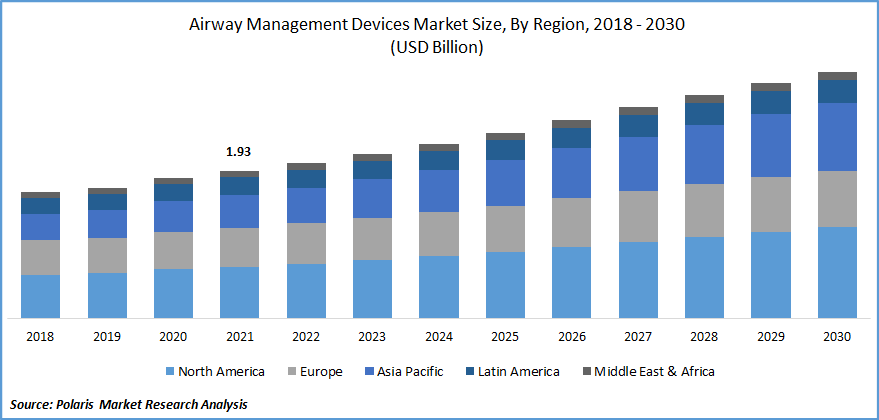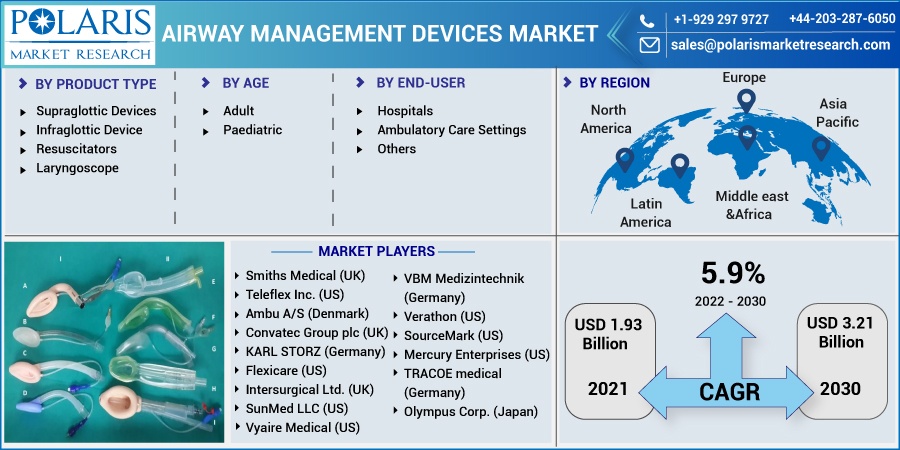
Airway Management Devices Market Share, Size, Trends, Industry Analysis Report, By Product Type (Supraglottic Device, Infraglottic Device, Resuscitators, Laryngoscope); By Patient Age (Adult, Pediatric); By End-Use; By Region; Segment Forecast, 2022 - 2030
- Published Date:Aug-2022
- Pages: 118
- Format: PDF
- Report ID: PM1246
- Base Year: 2021
- Historical Data: 2018-2020
Report Outlook
The global airway management devices market was valued at USD 1.93 billion in 2021 and is expected to grow at a CAGR of 5.9% during the forecast period. The significant revenue growth in the market is being driven by the rise in in-hospital stays post-COVID, a sharp rise in the completion of postponed surgeries, a well-developed healthcare infrastructure in the developed economies, coupled with rising in chronic conditions, particularly among geriatrics, played a positive in shaping future of the industry growth.

Know more about this report: Request for sample pages
Single-use airway management device use has significantly expanded, providing vendors with large growth prospects. Additionally, the increased demand for such management devices in emerging markets as a result of an increase in surgical procedures is offering considerable growth prospects for industry players.
As per the estimates of the WHO, more than 65 million people worldwide are estimated to have moderate-to-severe COPD. Furthermore, COPD is anticipated to rank as the third-leading cause of mortality globally.
This high prevalence, along with an increase in the use of anesthesia as a result of more surgeries, is anticipated to drive the demand for cutting-edge management devices, positively affecting the growth of the industry overall. The industry is anticipated to develop as a result of the rising demand for both lengthy treatments associated with lung diseases for both children and adults, as well as emergency care for long-term illnesses.
The COVID-19 epidemic has caused a surge in the number of patients being admitted to ICUs and emergency care. Patients suffering from severe infections frequently need ventilators and air pressure equipment to treat respiratory failures. Due to the high risk faced by healthcare professionals providing airway management treatment to COVID-19 patients and other patients throughout healthcare institutions, the market for single-use management devices has grown.

Know more about this report: Request for sample pages
Industry Dynamics
Growth Drivers
Airway difficulties frequently occur in patients with infectious, chronic, and cardiac disorders, requiring rapid medical care. Similar to this, those injured in car accidents and those with other traumatic injuries can need their airways cleared very once to ensure their safety. Worldwide demand for the airway management devices market is rising as a result of a large number of these cases. According to the 2021 health data of CDC, the number of emergency department visits among adults aged 18 years and above in the US has increased by about 30% during 1997-2020.
To ensure obstruction-free air passage, assess the severity of patients' conditions, and provide effective and prompt management of an obstructed or difficult airway, products like resuscitators, laryngoscopes, and customized masks are used in emergency settings. As a result, the need for such management devices is increasing globally due to the rise in the number of critically ill and trauma cases being admitted to emergency rooms and intensive care units.
Additionally, the COVID-19 pandemic epidemic has put a burden on the global healthcare system. Globally, admissions to emergency rooms and intensive care units have increased as a result of the pandemic's rapid spread. The need for ventilation support is also very significant among individuals who are critically ill.
Report Segmentation
The market is primarily segmented based on product type, age, end-user, and region.
|
By Product Type |
By Age |
By End-user |
By Region |
|
|
|
|
Know more about this report: Request for sample pages
Infraglottic Devices Segment is Expected to Witness the Fastest Growth
The infraglottic devices segment will dominate the market in 2021, according to the type of air management devices. This segment makes up a majority of the market, and the need for intubation is rising along with the demand for ventilation among patients experiencing respiratory failure.
After connecting with external breathing assistance systems, Infraglottic devices like endotracheal tubes and tracheostomy tubes are used during intubation to rescue the airway and give ventilation. Additionally, the incidence of acute respiratory failure is rising, which is increasing the demand for Infraglottic devices globally. These factors include the rising prevalence of chronic respiratory disorders, cardiovascular diseases, and respiratory tract infections.
For instance, in May 2021, The SonarMed airway monitoring system's U.S. commercial launch was announced by Medtronic plc, a leading provider of medical technology globally. The confirmed airway monitoring device, the first and only of its kind, continuously monitors the position of the endotracheal tube (ETT), checks for blockage, and provides doctors with the important data they need to make better-informed, life-saving decisions for their young patients. Over the anticipated given timeframe, these kinds of developments may offer a positive market outlook for airway control devices.
Pediatric Patients Accounted for the Second-Largest Market Share in 2021
During the anticipated period, the airway management devices market is anticipated to develop at the greatest CAGR for pediatric/neonatal patients. When a baby is born preterm and has breathing problems due to insufficient lung compliance, airway care is most needed. Airway care is in high demand among pediatric and neonatal patients due to the rise in preterm births worldwide.
The adult market is the second-largest category, with most adult patients visiting hospitals for treatments requiring oxygenation and ventilation. COPD, congestive heart failure, and hypertension will account for the majority of emergency department visits with chronic diseases in the United States, according to the Centers for Disease Control and Prevention (CDC).
Hospitals Segment is Expected to Hold the Significant Revenue Share
In 2021, the hospital industry held the biggest market share. The growing number of hospitals and the development of the economy and infrastructure, particularly in emerging nations, can be attributed to the significant share of this market. High development in the hospital sector is further supported by the increasing number of surgical procedures that need the use of air management devices for breathing, oxygenation, and anesthetic delivery.
Moreover, a higher share is the product of supportive infrastructure facilitating effective air management surgical operations. Additionally, the growing government activities targeted at enhancing safety and reducing adverse incidents play an important role in the segment's significant share.
For instance, organizations like the American Society of Anesthesiologists (ASA) pushed awareness about how important these management devices are for controlling challenging airways, which further increased the rate of adoption in hospitals. The ASA has also developed clinical practice recommendations and management techniques for difficult air management and effective ventilation.
The Demand in North America is Expected to Witness Significant Growth
North America has a highly developed healthcare system, a large number of well-known vendors, an expanding number of healthcare facilities, an increase in the prevalence of chronic respiratory diseases, and favorable government initiatives for airway management devices can all be used to describe the large share of this market segment.
The second-largest market share for airway management devices is held by Europe. The main factors driving the demand for the airway management devices market in Europe are aging populations, industrial development, and rising R&D spending. With aging, the risk of airway-related issues increases. A key element influencing the airway management devices market is the aging population.
Asia Pacific is expected to be the fastest-growing global market over the forecast period. This region is expected to grow exponentially during the forecast period as a result of the rise in the outsourcing of the manufacturing of these management devices to Asia Pacific nations, including China and India. High R&D spending by international firms and the existence of untapped prospects in this region also act as growth-promoting factors.
Competitive Insight
Some of the major players operating in the global market include Smiths Medical, Ambu A/S, Convatec Group, Flexicare, Intersurgical, SunMed LLC, VBM Medizintechnik, SourceMark, Teleflex, Vyaire Medical, Mercury Enterprises, TRACOE medical, Olympus, Verathon, Armstrong Medical, and Medtronic.
Recent Development
- In September 2020, The ScalpelCric kit was approved by the US FDA under 510(k) clearance, according to VBM Medizintechnik GmbH (Germany). According to the Difficult Airway Society (DAS) 2015 recommendations, the kit is intended to be used for performing cricothyrotomy procedures utilising the scalpel approach.
- Furthermore, in 2020, Smiths Medical announced the addition of a new PVC tracheostomy tube. A tube should be chosen when caring for a patient who has a tracheostomy to best meet the patient's unique clinical need. There are alternatives for a range of patients with the new tracheostomy tubes.
Airway Management Devices Market Report Scope
|
Report Attributes |
Details |
|
Market size value in 2021 |
USD 1.93 billion |
|
Revenue forecast in 2030 |
USD 3.21 billion |
|
CAGR |
5.9% from 2022 - 2030 |
|
Base year |
2021 |
|
Historical data |
2018 - 2020 |
|
Forecast period |
2022 - 2030 |
|
Quantitative units |
Revenue in USD billion and CAGR from 2022 to 2030 |
|
Segments covered |
By Form, By Product, By Application, By Region |
|
Regional scope |
North America, Europe, Asia Pacific, Latin America, Middle East & Africa |
|
Key companies |
Smiths Medical (UK), Teleflex Inc. (US), Ambu A/S (Denmark), Convatec Group plc (UK), KARL STORZ (Germany), Flexicare (US), Intersurgical Ltd. (UK), SunMed LLC (US), Vyaire Medical (US), VBM Medizintechnik (Germany), Verathon (US), SourceMark (US), Mercury Enterprises (US), TRACOE medical (Germany), Olympus Corp. (Japan), Armstrong Medical (China) and Medtronic plc. |
Gain profound insights into the 2024 Airway Management Devices Market with meticulously compiled statistics on market share, size, and revenue growth rate by Polaris Market Research Industry Reports. This thorough analysis not only provides a glimpse into historical trends but also unfolds a roadmap with a market forecast extending to 2032. Immerse yourself in the comprehensive nature of this industry analysis through a complimentary PDF download of the sample report.
